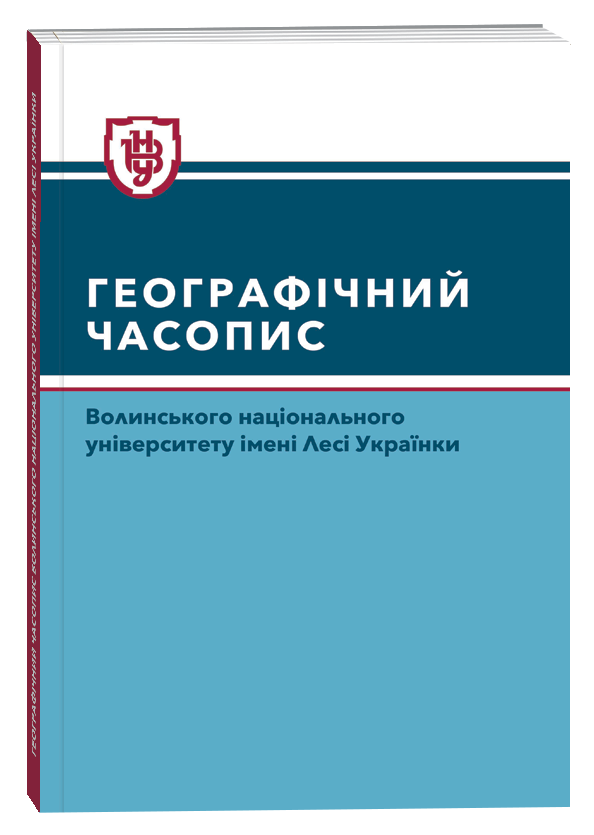CARTOGRAPHIC MODELING OF NITROGEN CONTENT DYNAMICS IN SOILS OF ZDOLBUNIV DISTRICT OF RIVNE REGION
DOI:
https://doi.org/10.32782/geochasvnu.2024.3.16Keywords:
soils, agrochemical surveys, nitrogen content, thematic maps, cartograms, dynamics.Abstract
Abstract. The current agrochemical state of domestic soils is generally not favorable. This makes it difficult to obtain sustainable high crop yields and avoid environmental destabilization of land use. The aim of this paper is to analyze and visualize the dynamics of nitrogen content in the soils of Zdolbuniv district, one of the most agriculturally developed regions of Rivne oblast, using cartographic modeling. This approach makes it possible to obtain an objective picture of the real state of the soil cover in terms of nitrogen content and, on this basis, to formulate proposals for its improvement. The research was based on the results of the last 9‒11 rounds of scheduled agrochemical certification of land carried out by the Rivne Department of the State Soil Protection Service in 2007‒2017. The information obtained was systematized, entered into a database and used to create author's maps using special ArcMap software. Cartograms were chosen as the main method of representation. The developed thematic maps make it possible to trace the spatial distribution of soil nitrogen content by former village councils over the last three rounds of agrochemical certification. This approach allows us to identify areas with very low, low and medium nitrogen content very low, low and medium nitrogen content, thus identifying possible problematic or potentially fertile land. In this regard, the soil condition in Kopytkivska and Dermanska Second Village Councils, where it is identified as the worst, is of the greatest concern. The maps also contain specific signatures of quantitative weighted average values of nitrogen content in the soil, which makes it possible to determine changes in this indicator in individual territorial units. The created mapping models are a necessary basis for further informed decisions in land use planning and management.
References
Авторизація програмного забезпечення – ArcMap. URL: https://desktop.arcgis.com/ru/arcmap/latest/getstarted/installation-guide/authorization-wizard.htm (дата звернення: 12.02.2024).
Реалії українського чорнозему: сучасний стан, еволюція, охорона та стале управління / С.А. Балюк, Л.І. Воротинцева, В.Б. Соловей, В.В. Шимель. Вісник аграрної науки. 2023. № 101 (3). С. 5‒13.
Ковальчук І.П., Ковальчук А.І. Структура цифрового атласу вартості земель України. Часопис картографії. 2019. Вип. 20. С. 5‒27.
Ковальчук І.П., Рожко О.В. Атласне картографування ґрунтів і земельних ресурсів у зарубіжних країнах. Наукові записки Тернопільського національного педагогічного університету імені Володимира Гнатюка. Серія «Географія». 2016. Вип. 2. С. 202‒213.
Мірошниченко М.М., Коваленко С.С. Просторово-часова нерівномірність забезпечення ґрунтів рухомими мікроелементами. Вісник аграрної науки. 2023. № 101 (4). С. 5‒14.
Наукові звіти Рівненської філії Державної установи «Держґрунтоохорона» за 2007‒2017 рр. (неопубл.).
Про стан родючості ґрунтів України : національна доповідь / за ред. С.А. Балюка, В.В. Медвєдєва, О.Г. Тараріка, В.О. Грекова, А.Д. Балаєва. Київ : Вік принт, 2010. 112 с.
Остапчук С.М., Мартинюк П.Ю. Картографічне моделювання основних агрохімічних властивостей ґрунтів Волинської області. Вісник Національного університету водного господарства та природокористування. Серія «Технічні науки». 2016. Вип. 2 (74). C. 231‒239.
Полупан М.І., Величко В.А., Соловей В.Б. Розвиток українського ґрунтознавства: генетичні та виробничі основи. Київ : Аграрна наука, 2015. 400 с.
Рожко О.В. Науково-методичні засади укладання великомасштабного електронного атласу земельних ресурсів адміністративного району : автореф. дис. … канд. геогр. наук. Київ : КНУ ім. Тараса Шевченка, 2018. 22 с.
Mapping of salt-affected soils. Technical specifications and country guidelines. Rome : FAO. 2020. 26 p.
Miller B.A., Schaetzl R.J. The historical role of base maps in soil geography. Geoderma. 2014. 230‒231. P. 329‒339.







